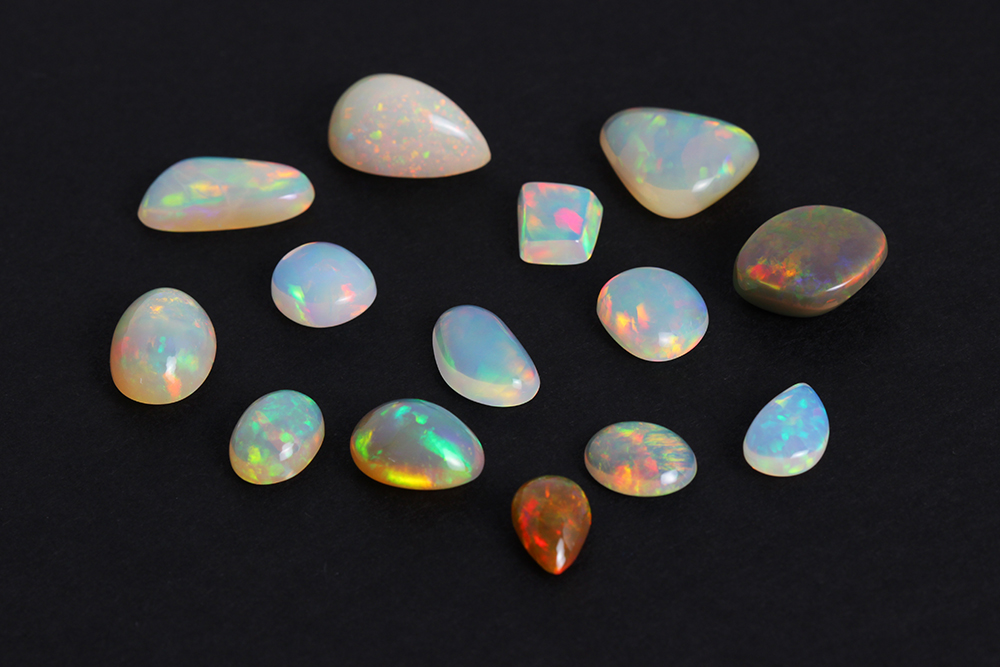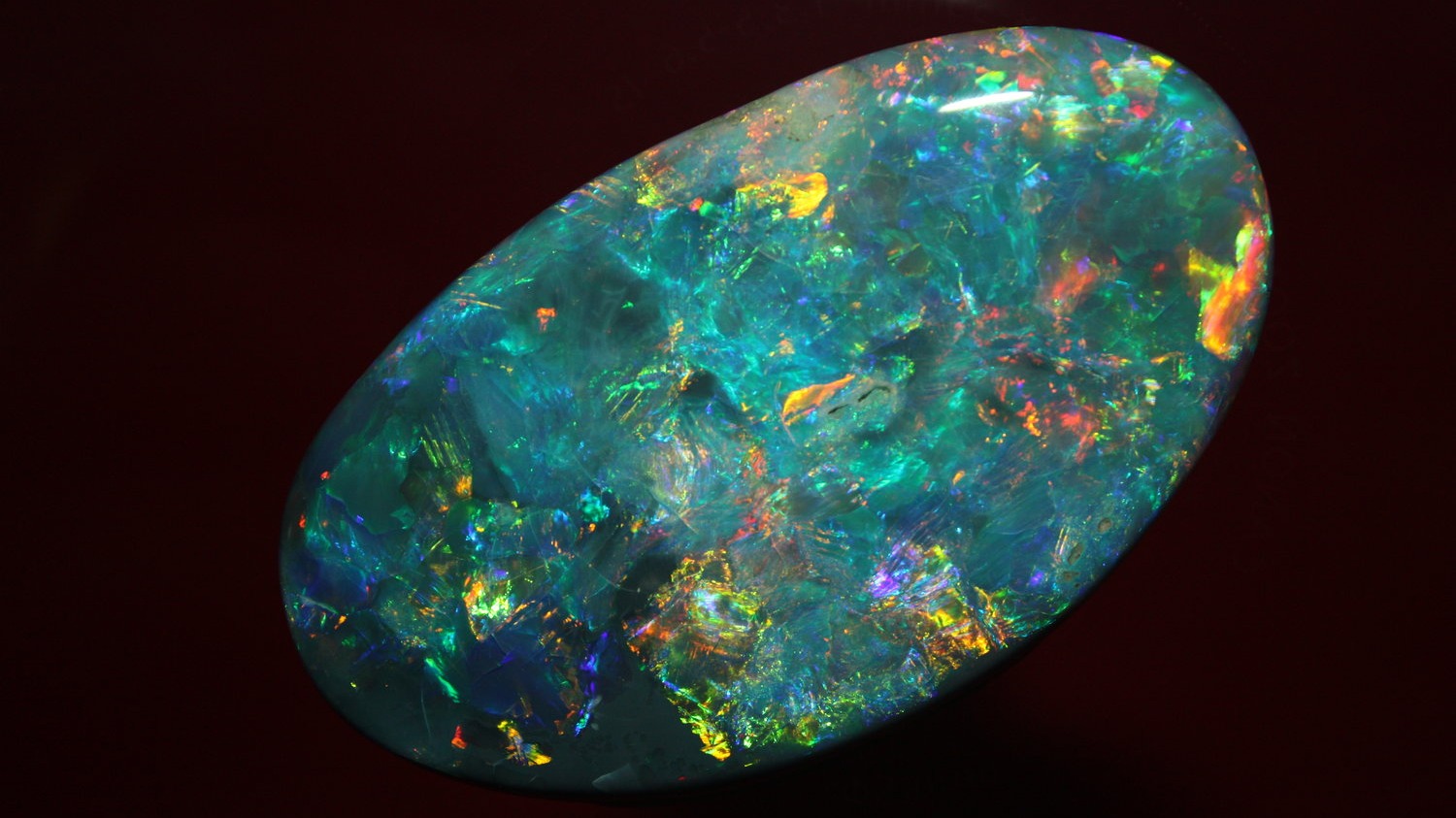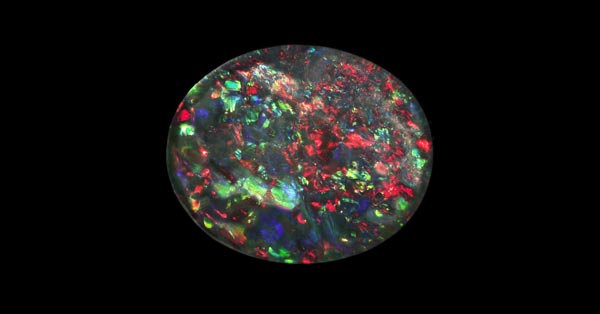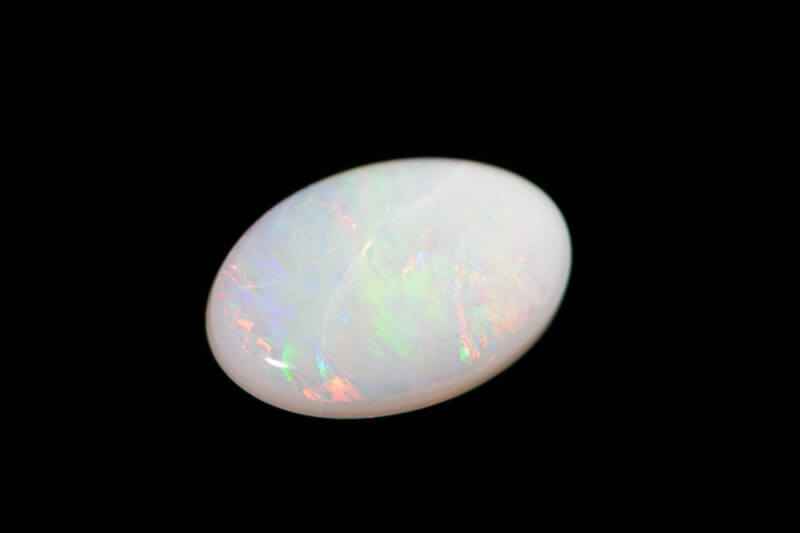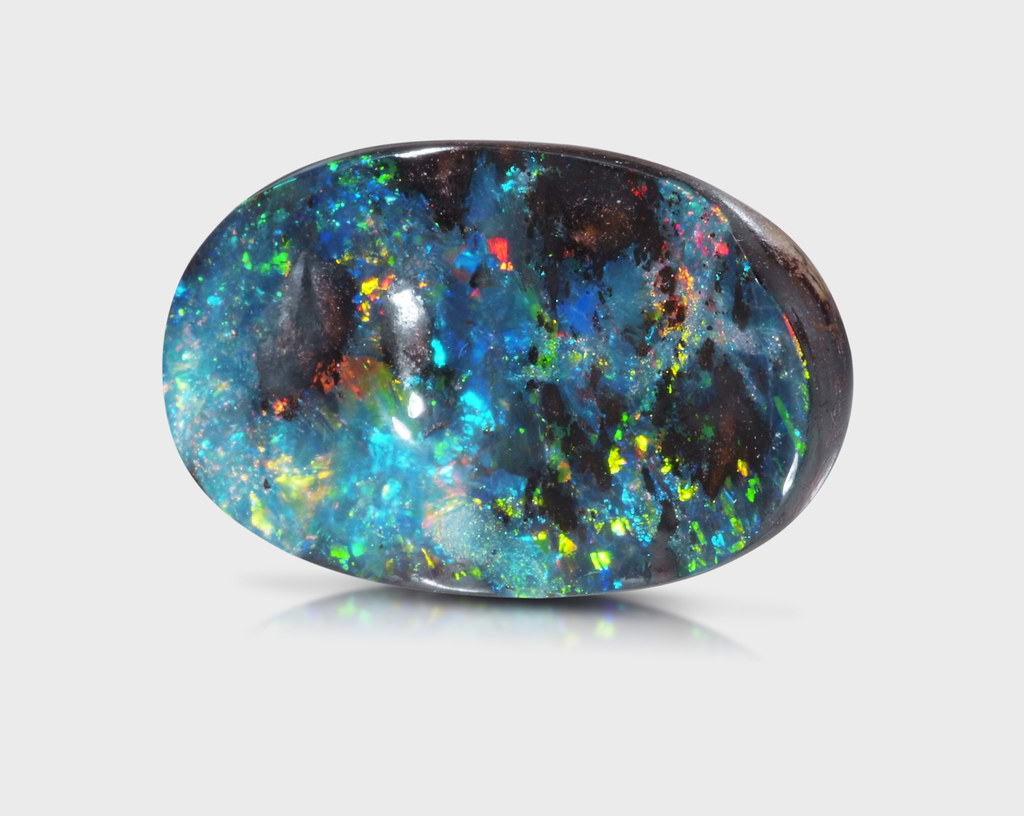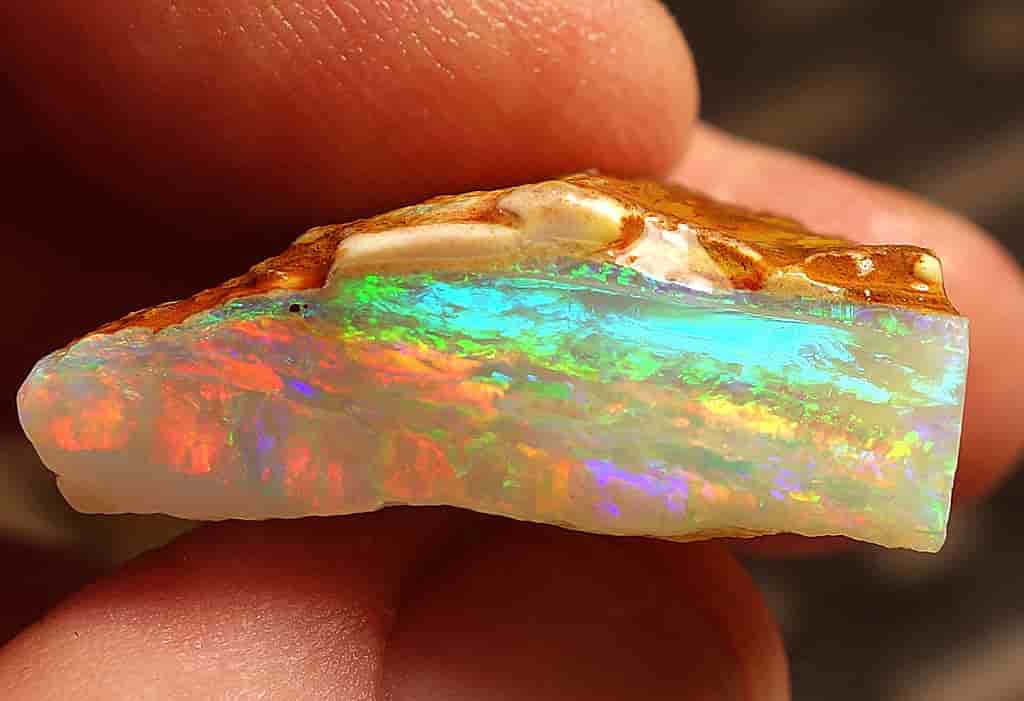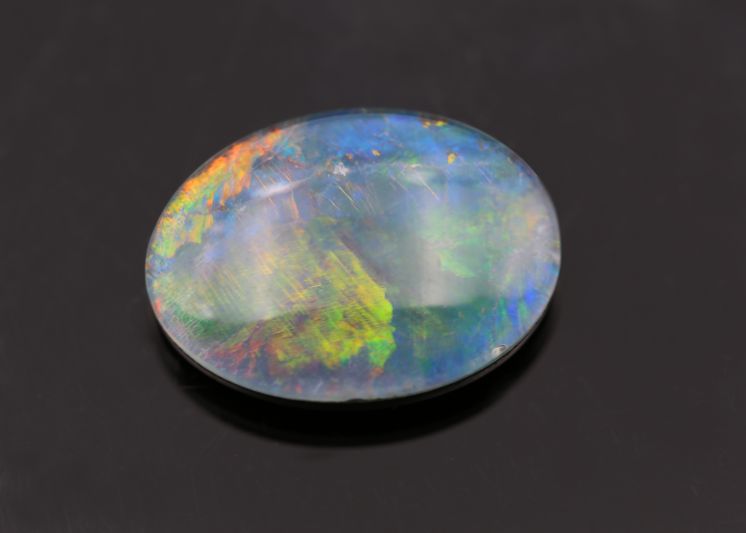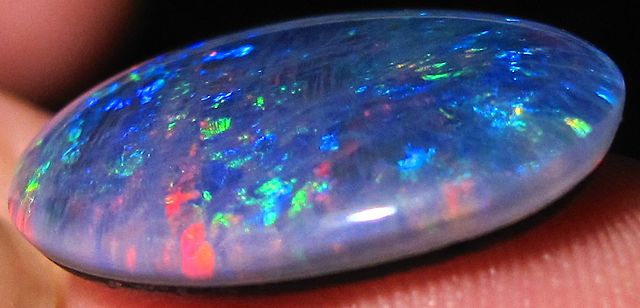Types Of Opals- Opalis derived from the Latin word opalus, which means "to notice a shift in color."
Two thousand years ago, opals were originally mined in Ervenica, also known as Czernowitza, a hilly area of Slovakia.
Opals became famous after they were found in Australia in 1869. Opal is an amorphous type of hydrated silica with no crystal structure.
It is available in two varieties: precious opal, which exhibits the play-of-color phenomenon, and ordinary opal, which does not.
With such a diverse range of colors and designs, it may appear that there are an infinite number of different types of opals available.
Opal, sometimes known as the "Queen of Gems," is one of the most stunning, valuable, and rare gemstoneson the planet.
Gem grade opal, which is used in different types of opaljewelry, is highly valued for its stunning array of spectacular colors, which varies from rich, deep blues and vivid greens to fiery oranges, dramatic red tones, neon pinks, electric purples, charming turquoise, golden yellows, and more.
Opals, in fact, may exhibit every spectrum color known to man.
People Also Ask
How Many Types Of Opal Are There?
Natural opals come in a variety of shapes and sizes.
There are four types of opal: black opal, white opal, crystal opal, and jelly opal.
Other types include fire opal, hyalite, water opal, hydrophane, and honey opal.
Which Type Of Opal Stone Is Best?
The colors themselves further break down desirable color play.
Traditionally, red is seen to be the most dominant hue, with orange coming in second and green coming in third.
Favored hues, on the other hand, might change depending on fashion or personal choice.
Furthermore, the play of color in an opal can alter depending on the viewing angle or kind of light.
For instance, red may predominate in the same area of an opal cabochon as blue predominates when seen from a different angle.
The most precious opals exhibit color play from all angles.
What Is The Rarest Opal Type?
Black opalis the most uncommon and valuable type of opal, and it has a black (or dark) body tone.
Black opals are available in every color of the rainbow.
Because of their dark body tone, the colors on the opal's face look rich and vibrant.
How dark is an opal if the color is ignored?
A black opal is one that is black or near-black in color.
Dark opal is opal that has a dark, but not black, body tone.
What Kind Of Opal Is In Australia?
Australia mines 97 percent of the world's Opal varieties.
Black Opals, Boulder Opals, White Opals, Crystal Opals, and Opal Doublets and Triplets are among the most beautiful.
hese are fashioned into a wide range of opal rings, opal earrings, opal pendants, and opal necklaces.
The remaining 3% originate from Mexico, Brazil, Ethiopia, and Hungary, however they are not of the same grade as Australian Opals.
Australia's opal fields were once an inland sea.
As the aeons passed and the seas receded, sea creatures were separated, marooned, and Opalised. The area soon dried up and became dry desert terrain.
Over time, groundwater containing silica solution evaporated (with some artesian springs still active deep "underground").
They left the phenomenon known as 'Opal' in selected places.
Types Of Opals
Opals are one-of-a-kind in the gem world.
Despite their origins in a single nation (Australia), they are the most colorful and artistically diverse gem kind on the planet.
Opals are typically multicolored, flashing changing colours depending on your viewpoint and the light circumstances, as every opal enthusiast knows.
To make sense of all that variance, opals are divided into several categories, the most common of which being white opaland black opal.
Is it correct to say that all white opals are white and all black opals are black?
No, not at all.
This article will teach you different types of Opals.
Black Opal
Black opals are the most popular in Australia and Asia.
The term 'black' refers to the deeper body tone of these opals.
They have color flash in all shades, which seems more powerful and vibrant because to the deeper backdrop tone.
Black opals with vivid color flash are more precious than other forms of opals due to their beauty and scarcity.
Water travels down into the soil, collecting up silica from sandstone to make black opal.
This silica-rich fluid is subsequently moved into natural faults or disintegrating fossils-caused fissures and voids.
As the water evaporates, a silica deposit forms. The deposit ultimately hardens into ordinary opal, and in exceptional cases, priceless opal.
Black Opal is the most precious and popular of all types of Opals.
Black Opal, which accounts for around 5% of the total and is discovered near Lightning Ridge in Northern NSW, is so named because it has a black base created by black or grey iron oxide impurities in the Opal.
White Opal
Light opals are white opals with a base tone ranging from colorless to medium grey.
Some people call them "white," however this term should only be used when the body color is exceptionally milky.
White opal is more prevalent and, due to its body tone, does not often exhibit the color as effectively as black opal.
Nonetheless, if a high-quality stone is found, white opals may be incredibly stunning in color.
Opal is Australia's national gemstone, and White Opal is the most well-known type, often found as a ring, pendant, or earrings.
White opal is mined in South Australia and, because to its lighter coloration, is easily distinguished from other forms of opal.
The white tone is caused by magnesium oxide in silica and is typically described as a "pale white" or "milky" complexion.
This form of opal is more common than any other types of Opals, but it doesn't make it any less lovely or expensive.
In 1915, Coober Pedy was discovered.
The majority of the 'white' or'milky' and crystal opals (together known as 'light opal') are mined here.
Coober Pedy is the primary producer of white precious opal, which is commonly found in stores across the world, notably in the United States.
The opal fields now cover an area of around 45 kilometers.
The opal level is composed of soft pinkish clay and soft bleached sandstone.
Boulder Opal
Boulder Opalis found in isolated patches of earth only in western Queensland, Australia.
Boulder Opal is made up of an Ironstone or Sandstone Boulder with an Opal seam that developed in the fissures of the Boulder.
Imagine the joy of picking through opal rough, not knowing what gorgeous opal you may unearth.
Boulder Opal is often cut and polished while still adhering to the boulder rock from which it originated.
Above is a side view of a polished Boulder Opal; observe how the opal and iron stone has developed unevenly.
Boulder Opal is likely one of the rarest and most precious types of Opals discovered in Australia, accounting for less than 5% of total Opal extracted.
Boulder Opal is expected to run out in the next ten years due to the difficulties in satisfying Native Title and EPA restoration standards.
Native Title is the process of obtaining permission from local Aboriginal communities before mining begins.
This is a very tough and time-consuming procedure.
Boulder Opal is created in the cracks and fissures of ironstone Boulders in a gel form maybe as recently as hundreds of years ago, and with the passage of ages, this jelly Opal solidified, leaving us with some stunning Boulder Opal examples.
Boulder Opal is found in ironstone as a filler between concentric layers or in random fissures.
Because the cutter must traverse the "hills and valleys" of the Boulder Opal surface, the cutting procedure is incredibly tough.
What we are left with is a truly one-of-a-kind and original gemstone.
Fire Opal
Fire opal is a clear to translucent opal with warm body hues ranging from yellow to orange to red.
Although it does not normally display any color play, a stone will occasionally produce intense green flashes.
The phrase "fire opal" is not often used in Australia, but the state of Querétaro in Mexico is the most famous source of fire opals; these opals are commonly referred to as "Mexican fire opals."
Fire opals with no color play are sometimes referred to as jelly opals.
Mexican opals are occasionally cut and polished in their ryholitic host material if it is hard enough.
Cantera opal is the name given to this variety of Mexican opal.
Crystal Opal
Crystal opal is transparent, which means that some light will pass through if you hold it up to the light.
It does not have a crystalline structure like amethystor diamond; it is named "crystal" because its translucency or transparency is similar to that of crystalline materials like rock crystal or glass.
When viewing Australian crystal opal with a light streaming through from behind, the opal's body turns a warm orange color.
Although the majority of crystal opal has a light body tone, it may sometimes be as dark as black opal.
In that instance, it is referred to as Black Crystal.
Doublet And Triplet Opals
Doublets and triplets are methods of enhancing the appearance of natural opals or different types of Opals.
The process of putting a black backing to a natural, valuable opal results in doublets.
A doublet is identical to a triplet except that it lacks a quartzcapping.
As with black opals, a dark backdrop or body color is preferable for highlighting the brilliant hues of opal.
This constructed doublet offers vibrant colors at a low cost.
Triplets take the construction process one step further by placing a transparent coating on top of the opal to protect it from scratching and chemical damage.
For the black background, the most frequent materials for this construction are common opal (also known as potch) and quartz for the top layer.
Doublet and triplet opals are composite stones made out of a slice of real Australian opal overlaid with other materials to mimic the appearance of a natural solid black opal.
Although doublets and triplets are not considered artificial, they are offered globally as an economical, acceptable, and popular alternative to black opal.
Conclusion
Opals are rainbows that you can hold in your hands, put around your neck, hang from your ears, and wrap around your wrists.
Different types of Opals, with their shimmering interior hues, go with everything. Colors such as red, green, yellow, blue, orange, and pink... Opals have everything.
Opals, at their most enticing, symbolize a swarm of elusive rainbows that flash, glitter, then conceal in an endless dance.
Opals have a cool inner glow that spreads from the centre of each stone, almost ethereal, with subtle splashes of blue, whispers of yellow, and occasional flashes of pink, green, orange, and red.
They are breathtaking stones with haunting beauty, internal rainbows, and/or intriguing fern-like features. Mother Nature's masterpieces are opals.
